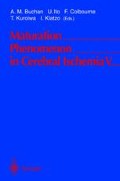Abstract
It has been well known that ischemic insults induced the hydrolytic breakdown of polyphosphoinositides by calcium-dependent phospholipase C, and diacylglycerol (DAG) was hydrolyzed to free fatty acids (FFAs) by DAG lipase [1, 2, 11, 22, 26]. The composition of FFAs consists mainly of stearic (C18:0) and arachidonic acids (C20:4). These processes are thought to act at early phase of the ischemia. Prolonged ischemia induces the degradation of membrane phospholipids, and the level of various phospholipids decrease at late phase of the ischemia. To determine a therapeutic time window of the ischemic penumbra, it is essential to evaluate the time course of the degradation of glycerophospholipids.
Access this chapter
Tax calculation will be finalised at checkout
Purchases are for personal use only
Preview
Unable to display preview. Download preview PDF.
References
Abe K, Kogure K, Yamamoto H, Imazawa M, Miyamoto K (1987) Mechanism of arachidonic acid liberation during ischemia in gerbil cerebral cortex. J Neurochem 48:503–509
Bazan NGJ (1970) Effects of ischemia and electroconvulsive shock on free fatty acid pool in the brain. Biochim Biophys Acta 218:1–10
Brugg B, Michel PP, Agid Y, Ruberg M (1996) Ceramide induces apoptosis in cultured mesen-cephalic neurons. J Neurochem 66:733–739
Casaccia-Bonnefil P, Aibel L, Chao MV (1996) Central glial and neuronal populations display differential sensitivity to ceramide-dependent cell death. J Neurosci Res 43:382–389
Folch J, Lees M, Sloane-Stanley GH (1957) A simple method for the isolation and purification of total lipids from animal tissues. J Biol Chem 226:497–509
Hannun YA (1996) Functions of ceramide in coordinating cellular responces to stress. Science 24:1855–1859
Hannun YA, Loomis CR, Merrill AHJ, Bell RM (1986) Sphingosine inhibition of protein kinase C activity and phorbol dibutyrate binding in vitro and in human platelets. J Biol Chem 261:12604–12609
Hara A, Taketomi T (1983) Detection of D-erythro and L-threo sphingosine bases in preparative sphingosylphosphorylcholine and its N-acylated derivatives and some evidence of their different chemical configurations. J Biochem 94:1715–1718
Harel R, Futerman AH (1993) Inhibition of sphingolipid synthesis affects axonal outgrowth in cultured hippocampal neurons. J Biol Chem 268:14476–14481
Hauser G, Eichberg J, Gonzalez-Sastre F (1971) Regional distribution of polyphosphoinositides in rat brain. Biochim Biophys Acta 248:87–95
Ikeda M, Yoshida S, Busto R, Santiso M, Ginsberg MD (1986) Polyphosphoinositides as a probable source of brain free fatty acids accumulated at the onset of ischemia. J Neurochem 47:123–132
Jayadev S, Linardic CM, Hannun YA (1994) Identification of arachidonic acid as a mediator of sphingomyelin hydrolysis in response to tumor necrosis factor. J Biol Chem 269:5757–5763
Kirino T (1982) Delayed neuronal death in the gerbil hippocampus following ischemia. Brain Res 239:57–69
Kitagawa K, Matsumoto M, Tagaya M, Hata R, Ueda H, Niinobe M, Handa N, Fukunaga R, Kimura K, Mikoshiba K, Kamada T (1990) Ischemic tolerance’ phenomenon found in the brain. Brain Res 528:21–24
Kubota M, Nakane M, Narita K, Nakagomi T, Tamura A, Hisaki H, Shimasaki H, Ueta N (1998) Mild hypothermia reduces the rate of metabolism of arachidonic acid following postischemic reperfusion. Brain Res 779:297–300
Kubota M, Narita K, Nakagomi T, Tamura A, Shimasaki H, Ueta N, Yoshida S (1996) Sphingomyelin changes in rat cerebral cortex during focal ischemia. Neurol Res 18:337–341
Lee C, Hajra AK (1991) Molecular species of diacylglycerols and phosphoglycerides and the postmortem changes in the molecular species of diacylglycerols in rat brains. J Neurochem 56:370–379
Nakano S, Kogure K, Abe K, Yae T (1990) Ischemia-induced alterations in lipid metabolism of the gerbil cerebral cortex: I. Changes in free fatty acid liberation. J Neurochem 54:1911–1916
Nitatori T, Sato N, Waguri S, Karasawa Y, Araki H, Shibanai K, Kominami E, Uchiyama Y (1995) Delayed neuronal death in the CAl pyramidal cell layer of the gerbil hippocampus following transient ischemia is apoptosis. J Neurosci 15:1001–1011
Obeid LM, Linardic CM, Karolak LA, Hannun YA (1993) Programmed cell death induced by ceramide. Science 259:1769–1771
Schwarz A, Futerman AH (1997) Distinct roles for ceramide and glucosylceramide at different stages of neuronal growth. J Neurosci 17:2929–2938
Siesjo BK, Katsura K, Zhao Q, Folbergrova J, Pahlmark K, Siesjo P, Smith ML (1995) Mechanisms of secondary brain damage in global and focal ischemia: a speculative synthesis. J Neurotrauma 12:943–956
Stoffel W, Melzner I (1980) Studies in vitro on the biosynthesis of ceramide and sphingomyelin. A re-evaluation of proposed pathways. Hoppe-Seyler’s Z Physiol Chem 361:755–771
Tamura A, Graham DI, McCulloch J, Teasdale GM (1981) Focal cerebral ischaemia in the rat: 1. Description of technique and early neuropathological consequences following middle cerebral artery occlusion. J Cereb Blood Flow Metab 1:53–60
Tamura A, Graham DI, McCulloch J, Teasdale GM (1981) Focal cerebral ischaemia in the rat: 2. Regional cerebral blood flow determined by [14Cliodoantipyrine autoradiography following middle cerebral artery occlusion. J Cereb Blood Flow Metab 1:61–69
Yoshida S, Inoh S, Asano T, Sano K, Kubota M, Shimazaki H, Ueta N (1980) Effect of transient ischemia on free fatty acids and phospholipids in the gerbil brain: Lipid peroxidation as a possible cause of postischemic injury. J Neurosurg 53:323–331
Yoshida S, Inoh S, Asano T, Sano K, Kubota M, Shimazaki H, Ueta N (1980) Effect of transient ischemia on free fatty acids and phospholipids in the gerbil brain. Lipid peroxidation as a possible cause of postischemic injury. J Neurosurg 53:323–331
Zhang JP, Sun GY (1995) Free fatty acids, neutral glycerides, and phosphoglycerides in transient focal cerebral ischemia. J Neurochem 64:1688–1695
Author information
Authors and Affiliations
Editor information
Editors and Affiliations
Rights and permissions
Copyright information
© 2004 Springer-Verlag Berlin Heidelberg
About this paper
Cite this paper
Kubota, M. et al. (2004). Sphingolipids Metabolism Following Cerebral Ischemia. In: Buchan, A.M., Ito, U., Colbourne, F., Kuroiwa, T., Klatzo, I. (eds) Maturation Phenomenon in Cerebral Ischemia V. Springer, Berlin, Heidelberg. https://doi.org/10.1007/978-3-642-18713-1_25
Download citation
DOI: https://doi.org/10.1007/978-3-642-18713-1_25
Publisher Name: Springer, Berlin, Heidelberg
Print ISBN: 978-3-540-40874-1
Online ISBN: 978-3-642-18713-1
eBook Packages: Springer Book Archive

